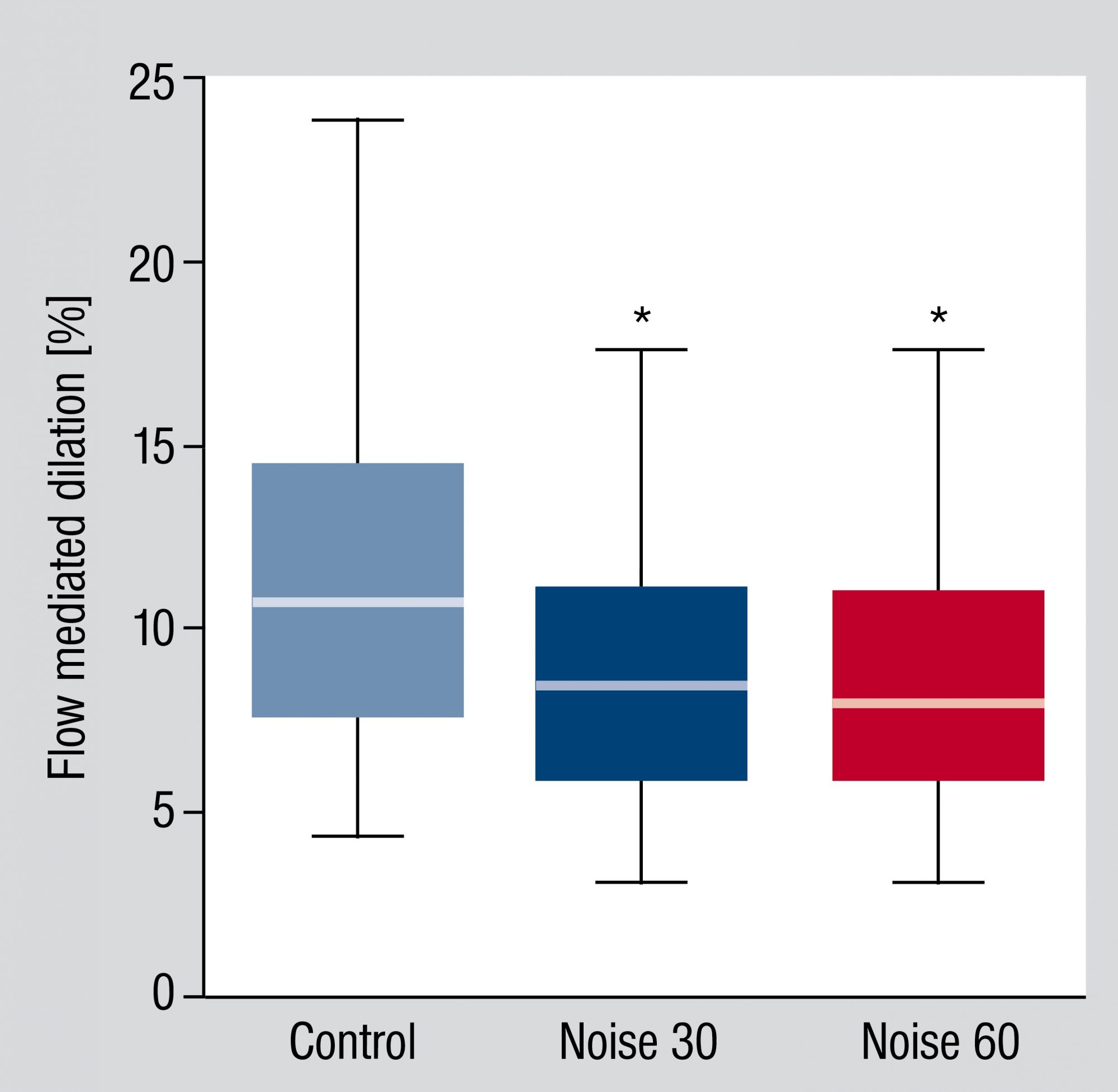The cardiovascular side effects of night-time train noise is placed under the spotlight here by a group of experts from Gutenberg-University Mainz in Germany and the Danish Cancer Society
According to the World Health Organisation (WHO), at least 1 million healthy life years are lost annually from traffic-related noise in Western Europe. The annual noise-related cardiovascular disease (CVD) burden of noise is substantial in Europe, as an estimate found environmental noise to result in 1.7 million cases of hypertension, 80,000 hospital admissions, and at least 18,000 excess deaths. It was estimated that reducing noise levels by 5 dB(A) could reduce hypertension by 1.4% and ischemic heart disease by 1.8%, saving 3.9 billion dollars in health costs1. The WHO, however, indicates the urgent need for additional clinical evidence, based on both longitudinal studies and experimental studies, to assess the cardiovascular and metabolic adverse health impacts of noise2.
Railway noise
The WHO Environmental Noise Guidelines for the European Region also stated that railway noise may increase the risk for ischemic heart disease, whereas the data are less clear concerning hypertension, stroke or diabetes risk. Studies indicate that years of life lost due to traffic are dominated by air pollution, whereas morbidity and quality of life are dominated by noise2. The opening of the new Gotthard tunnel, the world’s longest and deepest rail tunnel will create a mainline rail connection between Rotterdam in the Netherlands and Genoa in Italy. The Rotterdam-Genoa rail freight corridor (EU Corridor 24) has been one of the most important transport links in Europe for centuries and around 700 million tonnes of freight are transported along this corridor every year, which constitutes approximately half of the total freight carried between the north and south of Europe.
Reducing noise from rail freight has been identified by the European rail sector itself as a key objective. This issue has a high political sensitivity, particularly in densely populated regions in the centre of Europe close to the rail freight corridor, which has a high volume of traffic.
Endothelial dysfunction
So far, only limited research on the acute effects of traffic noise exposure on vascular (endothelial) function parameters exists. Numerous clinical studies have investigated endothelial function in subjects with cardiovascular disease and established the prognostic importance of coronary and peripheral endothelial dysfunction, not only for patients with coronary artery disease (CAD), peripheral arterial occlusive disease, arterial hypertension, postmenopausal women and heart failure but also in healthy subjects (for review see 3). Previously, we demonstrated that acute night-time aircraft noise exposure (30 and 60 simulated starting and landing events during one study night) worsened endothelial function (impaired flow-mediated dilation) in healthy volunteers4 and resulted in even more pronounced endothelial dysfunction in patients with already established CAD or cardiovascular risk factors5.
Thus, so far it has remained unclear whether acute night-time train exposure may induce subclinical atherosclerosis, such as endothelial dysfunction and other functional and/or biochemical changes.
Recently, we established that following night-time train noise exposures (30 or 60 simulated passing train noise patterns during one study night), the flow-mediated dilation of the brachial artery was markedly impaired in the Noise30 and the Noise60 group6 (Figure 1).

The quality of the participants’ sleep was also impaired after both Noise30 and Noise60 study nights. Previously, we have demonstrated that the antioxidant vitamin C reversed aircraft noise-induced endothelial dysfunction suggesting that noise-induced endothelial function is mediated by the production of reactive oxygens species (induction of oxidative stress) within the vasculature. As in the previous aircraft noise study, we demonstrated that vitamin C improved flow-mediated dilation more substantially in the Noise30 and Noise60 groups as compared to the control subjects6. Further evidence for reactive oxygen species involvement emerges with the targeted proteomic analysis in this study, which showed that after Noise60, plasma proteins within redox, pro-thrombotic and pro-inflammatory pathways were significantly impacted versus controls6. This data implies that exposure to nocturnal train noise both impairs endothelial function and also induces proteomic changes toward a pro-inflammatory and pro-thrombotic phenotype that could provide a molecular connection to the increased cardiovascular risk observed in epidemiological noise studies.2, 7
Impaired sleep
Impaired endothelial function was associated with impaired sleep quality of the exposed subjects.
Importantly, sleep fragmentation and insufficient sleep (deprivation) are well-known triggers of endothelial dysfunction and facilitate the development of cardiovascular disease and an increase in overall mortality7. Of note, we do not consider impaired sleep quality a confounder of noise effects on endothelial function, but a direct consequence of noise exposure. Interestingly, others found that daily sleep deprivation for two hours a day for eight days induces endothelial dysfunction in healthy subjects, and the degree of endothelial dysfunction was comparable to that observed in 24-hour shift-workers.
The findings that night-time train noise can cause vascular damage and a prothrombotic, as well as proinflammatory milieu in plasma of even healthy subjects, may have important public health implications since the number of people exposed to high levels of night-time railway noise is increasing in Europe, in particular with a rise in number of nightly freight trains. Thus, noise mitigation strategies including speed reductions of trains and noise protection walls are important to protect people living close to highly trafficked railway tracks from cardiovascular adverse effects.
References
- Burden of disease from environmental noise – Quantification of healthy life years lost in Europe In. Copenhagen: World Health Organization. Regional office for Europe; 2011.
- Kempen EV, Casas M, Pershagen G, Foraster M. WHO Environmental Noise Guidelines for the European Region: A Systematic Review on Environmental Noise and Cardiovascular and Metabolic Effects: A Summary. Int J Environ Res Public Health 2018;15(2).
- Munzel T, Sinning C, Post F, Warnholtz A, Schulz E. Pathophysiology, diagnosis and prognostic implications of endothelial dysfunction. Ann Med 2008;40(3):180-96.
- Schmidt FP, Basner M, Kroger G, Weck S, Schnorbus B, Muttray A, Sariyar M, Binder H, Gori T, Warnholtz A, Munzel T. Effect of nighttime aircraft noise exposure on endothelial function and stress hormone release in healthy adults. European heart journal 2013;34(45):3508-14a.
- Schmidt F, Kolle K, Kreuder K, Schnorbus B, Wild P, Hechtner M, Binder H, Gori T, Munzel T. Nighttime aircraft noise impairs endothelial function and increases blood pressure in patients with or at high risk for coronary artery disease. Clinical research in cardiology: official journal of the German Cardiac Society 2015;104(1):23-30.
- Herzog J, Schmidt FP, Hahad O, Mahmoudpour SH, Mangold AK, Garcia Andreo P, Prochaska J, Koeck T, Wild PS, Sorensen M, Daiber A, Munzel T. Acute exposure to nocturnal train noise induces endothelial dysfunction and pro-thromboinflammatory changes of the plasma proteome in healthy subjects. Basic Res Cardiol 2019;114(6):46.
- Munzel T, Schmidt FP, Steven S, Herzog J, Daiber A, Sorensen M. Environmental Noise and the Cardiovascular System. J Am Coll Cardiol 2018;71(6):688-697.











